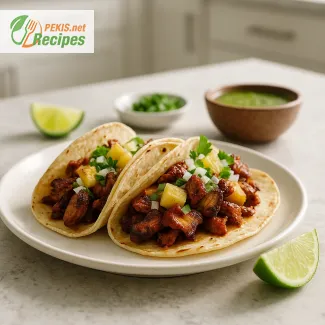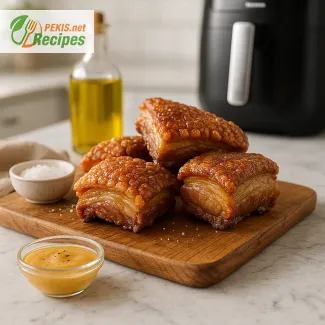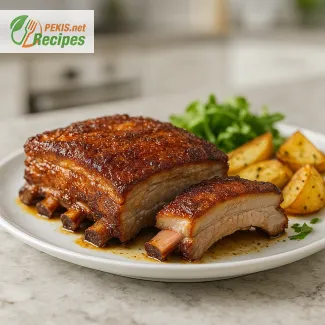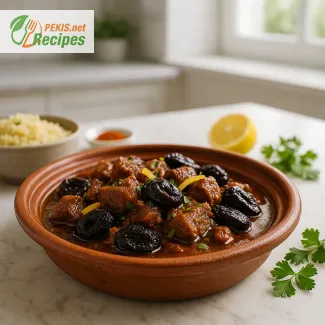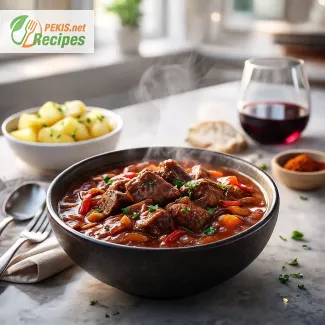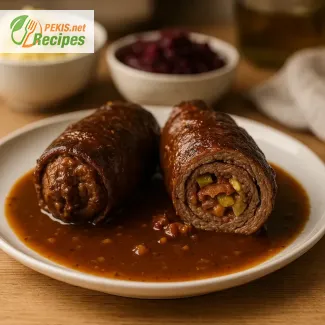
Discover the Timeless Comfort of German Rouladen
A heritage dish that brings hearty flavors and family memories to your table
There are few dishes that evoke the feeling of a cozy family Sunday meal quite like German Beef Roulades (Rinderrouladen). This beloved dish, passed down through generations, is a staple in traditional German cuisine, especially cherished during weekend gatherings or festive occasions. Known for its rich, layered flavors and comforting textures, Rinderrouladen brings together thin slices of beef rolled around savory fillings and braised slowly to perfection. The result is melt-in-your-mouth tenderness, complemented by a deeply flavorful gravy that defines this iconic dish.
The essence of traditional German home cooking
Rinderrouladen is more than just a meal—it’s a culinary tradition deeply rooted in German family life. The classic preparation involves thin beef slices smeared with mustard, layered with smoked bacon, onions, and pickles, then tightly rolled and browned. What follows is a slow braise in a rich broth until every bite is fork-tender and infused with savory depth. The aroma alone can transport anyone to a German kitchen where grandmothers lovingly prepare meals that bring families together.
Each roulade is a perfect harmony of salty, tangy, and umami notes, with textures that satisfy and flavors that develop over hours. It's traditionally served with creamy mashed potatoes, buttered spaetzle, or braised red cabbage, creating a wholesome plate that balances richness with subtle acidity and comfort.
A dish rich in history and regional pride
Though popular across Germany, beef roulades have subtle regional variations. In southern parts like Bavaria, red wine is often added to the braising liquid, lending a deeper complexity. In the north, roulades might include carrots or celery in the filling for added sweetness and balance. Despite these regional twists, the core of the dish remains unchanged—a testament to its timelessness.
The German word Rinderroulade comes from the French "roulade," meaning "to roll," highlighting the cross-cultural influence that shaped this recipe during the 19th century. Initially reserved for special occasions, German Rouladen have become a comforting dish that symbolizes togetherness, family bonds, and nostalgic flavors.
What makes a roulade truly authentic?
Authenticity lies in the ingredients, technique, and patience. Thin slices of top round or rump steak are essential; the meat must be tender enough to roll and robust enough to withstand long braising. The filling should always balance savory and tangy components, with the mustard playing a crucial role in adding both flavor and tenderness. Quality bacon and crunchy pickles introduce smoky and acidic layers, while onions caramelize slightly during cooking to bring sweetness.
Browning the roulades before braising is a critical step—it builds the foundation for a deeply flavorful gravy. This step requires careful attention to detail, as the fond (browned bits left in the pan) will later enrich the sauce. A splash of red wine or beef stock deglazes the pan and elevates the final dish into something truly unforgettable.
The cultural significance of Rinderrouladen
To many Germans, Rinderrouladen represent far more than food. They are a connection to childhood, to holidays spent with family, and to the quiet comfort of a home-cooked meal. This dish often appears on Christmas, Easter, or Sunday lunch tables, where the act of preparing it becomes as important as eating it. It requires time, intention, and care—all of which mirror the values this recipe embodies.
Today, German Beef Roulades have found their way into international kitchens, celebrated by home cooks and professional chefs alike. They are a symbol of tradition preserved through flavor—a recipe that invites slow preparation, shared meals, and lasting memories.
Why this dish still resonates today
In a fast-paced world where quick meals dominate, there's a growing appreciation for dishes that require time, layering, and care. Rinderrouladen is one such dish—a slow-cooked marvel that rewards patience with deeply satisfying flavor. It fits perfectly within today’s culinary renaissance of heritage recipes, where people seek to reconnect with their roots through food.
This recipe brings together traditional techniques and wholesome ingredients, offering not just nourishment but emotional warmth. Whether you're preparing it for a special gathering or a cozy weekend dinner, German Beef Roulades provide a deeply satisfying experience that transcends trends and time.
Explore the preparation and bring this tradition home
In the following section, you'll find a detailed, easy-to-follow recipe that stays true to the original German preparation, with thoughtful instructions to help you recreate this dish authentically in your own kitchen. From choosing the right cut of beef to mastering the perfect roll, you'll learn everything needed to honor this classic the way grandmothers across Germany have done for generations.
Step 1 – Prepare the beef:
Lay out the beef slices on a clean surface. Spread a thin layer of yellow mustard over each slice. Place a strip of bacon, some onion slices, and pickle strips in the center of each.
Step 2 – Roll and secure:
Roll up each slice tightly, tucking in the sides, and secure with kitchen twine or toothpicks.
Step 3 – Brown the roulades:
Heat vegetable oil in a large pot over medium-high heat. Brown the roulades on all sides, then remove and set aside.
Step 4 – Prepare the braising base:
In the same pot, add onion, carrot, celery, and garlic. Sauté until softened, then stir in the tomato paste and cook for 1 minute.
Step 5 – Deglaze and braise:
Pour in the red wine to deglaze the pot, scraping up any browned bits. Simmer for 2–3 minutes, then add the beef broth and bay leaves. Return the roulades to the pot. Cover and simmer on low heat for 90 minutes.
Step 6 – Make the gravy:
Remove the roulades and keep warm. Strain the sauce into a clean saucepan. Bring to a simmer and whisk in the flour to thicken. Season with salt and pepper to taste.
Step 7 – Serve:
Remove twine or toothpicks from the roulades. Slice and serve with the hot gravy. Traditional sides include mashed potatoes, red cabbage, or spaetzle.
Reinventing German Rouladen with Flavorful Twists
Smart improvements and culinary tips to elevate this traditional beef classic
German Beef Roulades (Rinderrouladen) are deeply cherished for their savory richness and comforting appeal, but even timeless recipes can be enhanced with thoughtful touches. Whether you're looking to intensify flavors, modernize the dish for dietary needs, or simply avoid common pitfalls, this guide explores how to adapt and refine this beloved German classic without losing its essence.
Use better cuts and preparation techniques
While traditional topside or rump steak works well for Rinderrouladen, substituting it with flank steak or sirloin tip can improve tenderness and reduce cooking time. These cuts are more marbled, which translates to a richer, more succulent result. Marinating the beef slices in a blend of mustard, red wine, and garlic for an hour before assembling the roulades deepens the flavor and helps break down tougher fibers, making the rolls melt in your mouth.
Enhance the filling with gourmet variations
The classic filling of mustard, pickles, onion, and bacon is a harmonious balance of tang, smoke, and sweetness. To refine it further, try adding a thin slice of prosciutto or pancetta instead of bacon for a more delicate saltiness. Replace raw onions with caramelized shallots to add sweetness and complexity. A small spoonful of horseradish cream or sun-dried tomato paste layered under the mustard can elevate the umami depth of the roulades.
Adding fresh thyme, dijon mustard, or even grated parmesan to the filling introduces sophisticated notes without overpowering the core character of the dish. However, restraint is key—too many additions can overwhelm the traditional flavors.
Rethink the sauce for more richness
The gravy is the heart of the dish. To enhance it, deglaze the pan not only with red wine but also a splash of Madeira or sherry vinegar for subtle sweetness and acidity. Roasting the vegetables (carrot, celery, onion) beforehand adds caramelized flavor to the sauce. For extra depth, stir in a teaspoon of cocoa powder or a square of dark chocolate while reducing the gravy—it sounds unusual but adds richness without tasting sweet.
If you're aiming for a lighter version, skip the roux (flour) and thicken the sauce with pureed root vegetables like parsnip or cauliflower. This not only boosts the nutritional profile but keeps the sauce velvety and gluten-free.
Healthier alternatives without losing authenticity
To make Rinderrouladen healthier, start by trimming visible fat from the beef and using turkey bacon or vegetarian smoked strips as a substitute for traditional pork. Opt for low-sodium broth to control salt levels and use stone-ground mustard without added sugar.
Those avoiding red meat can adapt the recipe by using chicken breast fillets or plant-based seitan sheets, stuffed and rolled similarly. While the cooking time will be shorter, the flavor can be preserved with creative seasoning and a rich vegetable-based gravy.
Why homemade always wins
Preparing Rinderrouladen from scratch allows full control over ingredients, ensuring quality and freshness. Unlike store-bought or pre-packaged versions, homemade roulades are free from preservatives, artificial flavors, and excess salt. The act of assembling and braising the rolls connects you to a lineage of tradition and care, reinforcing the emotional value of cooking.
Moreover, the satisfaction of tailoring the dish to your personal taste—or dietary restrictions—makes the experience both rewarding and customizable. It’s a chance to turn a familiar recipe into something uniquely yours while preserving its heritage.
Common mistakes and how to avoid them
A few missteps can impact the final outcome of your roulades:
- Using cuts that are too thick makes rolling difficult and can lead to uneven cooking. Always pound the beef slices to a uniform thinness.
- Overstuffing the roulades can cause them to unravel during braising. Keep fillings modest and secure with toothpicks or kitchen twine.
- Skipping the browning stage results in a flat-tasting sauce. Proper searing builds essential flavor.
- Using too much salt, especially when bacon and pickles are involved, can make the dish overly salty. Always taste the gravy before adjusting seasoning.
Serving enhancements and flavor pairings
Rinderrouladen pairs best with creamy mashed potatoes, but you can switch to celeriac mash, buttered spaetzle, or herb barley for variation. A side of braised red cabbage, with its sweet and sour profile, perfectly complements the richness of the meat.
For a lighter presentation, serve with roasted root vegetables, steamed green beans, or a crisp arugula salad with apple vinaigrette. These pairings add freshness and balance to the dish.
As for drinks, a robust red wine such as Pinot Noir or a dark German lager brings out the depth of the beef, while apple cider vinegar water cleanses the palate between bites.
Reinventing without losing tradition
Improving German Rinderrouladen doesn't mean replacing its essence. Small, thoughtful changes—whether in preparation, filling, or sides—can result in a more flavorful, healthier, and customized version of this classic. It's a dish that welcomes experimentation while rewarding respect for tradition, making it a perfect candidate for both modern cooks and nostalgic palates.
Allergens present in the recipe:
- Mustard (yellow mustard)
- Celery (in the base vegetables)
- Gluten (all-purpose flour)
Suggestions to eliminate allergens and gluten:
- Replace mustard with a homemade blend of turmeric and vinegar for similar tang.
- Omit celery or replace with zucchini for texture without the allergen.
- Use gluten-free flour (like rice flour or cornstarch) to thicken the gravy.
Vitamins and minerals per serving (approximate):
- Vitamin B12: 3.2 µg – Supports red blood cell formation and nervous system health
- Iron: 4.5 mg – Crucial for oxygen transport in the blood
- Zinc: 5.6 mg – Enhances immune function and wound healing
- Vitamin A: 450 µg – Supports vision and immune function
- Potassium: 620 mg – Helps regulate fluid balance and muscle contractions
Antioxidants per serving (approximate):
- Lycopene: 1.1 mg – From tomato paste, may protect against oxidative stress
- Beta-carotene: 1.8 mg – From carrots, supports skin and eye health
- Quercetin: 2.4 mg – Found in onions, may reduce inflammation and support heart health
